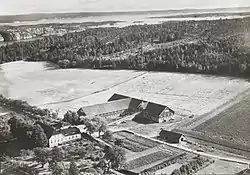Thorsø, Norway
Thorsø or Tose is a farm located in the former municipality of Torsnes (until 1910 part of Borge) in Østfold county, Norway. The first written source found about this farm is from 1472, in the form of Tosowe. This is one of three placenames in Østfold that are believed to derive from Old Norse Þórshof and thus indicate an old location for worshipping the Norse god Thor, a temple or "hof".[1][2] Jan de Vries pointed out in his work on Germanic religion that although instances of placenames derived from Þórshof are fairly common in Norway, they are all grouped around the Oslofjord.[3]
Thorsø | |
|---|---|
Village | |
 Thorsø, between 1975 and 1979 | |
 Thorsø Location in Norway | |
| Coordinates: 59.161854°N 11.094028°E | |
| Country | Norway |
| County | Østfold |
| Municipality | Fredrikstad |
| Time zone | UTC+1 (CET) |
| • Summer (DST) | UTC+2 (CEST) |
As of 1998, the property consisted of 1,360 hectares (3,400 acres) of land, 108.6 hectares (268 acres) under cultivation and 650 hectares (1,600 acres) woodland.[4] The main house dates to 1900, replacing one destroyed by fire in 1899.[4]
Archaeological discoveries on the farm indicate that settlement there dates back to ancient times and include stone axes and two 12th-century runestones.[5][6][7][8] The first known owner of the property was Alv Haraldsson (Bolt) (d. 1412). Under Oluf Kalips it became an aristocratic estate, and it has since belonged to the Rosenvinge, Bildt, Budde, Sehested and Stang families.[4]
Prominent owners of the Thorsø estate have included war minister Hans Angell Gude, who disappeared from the house mysteriously in the autumn of 1814, thought to have been murdered,[4][5] and the Norwegian politician and agronomist Kai Møller.[4] Bjørnstjerne Bjørnson wrote his Sigurd Jorsalfar while staying there in 1872.[5]
The estate is the "Lindeby" of a trilogy of historical novels by Ingeborg Møller, whose father's family owned the property: Vårfrost (1931), Lindeby (1933), and Runestenene (1934).[9][10]
References
- Oluf Rygh, Norske gaardnavne: Oplysninger samlede til brug ved Matrikelens Revision, efter offentlig Foranstaltning udgivne med tilføiede Forklaringer, Volume 1 Smaalenenes amt, Kristiania: Fabritius, 1897, OCLC 257707758, p. 276 (in Danish)
- Axel Olrik and Hans Ellekilde, Nordens gudeverden, Volume 1 Vætter og helligdomme, Copenhagen: Gad, 1926, OCLC 907245, p. 544 (in Danish)
- Jan de Vries, Altgermanische Religionsgeschichte Volume 2, Grundriß der germanischen Philologie 12/2, 2nd ed. 1957, repr. 3rd ed. Berlin: de Gruyter, 1970, OCLC 769214225, p. 119 (in German): see also Map II, p. 116, and for Torsnes, Map II, p. 117.
- Terje Bratberg, "Thorsø", Store norske leksikon (in Norwegian)
- Lise and Gustav Thorsø Mohr, Parts of the Thorsø Story, tr. Ann-Sissel Holter, retrieved December 12, 2012.
- Stone Age settlement site at Thorsø, Kulturminnesøk.no (in Norwegian)
- Iron-Age defences at Thorsø, Kulturminnesøk.no (in Norwegian)
- Runestone at Thorsø, Kulturminnesøk.no (in Norwegian)
- Helga Groth, Hovedlinjer i mellomkrigstidens norske litteratur, Humanistiske skrifter 1, Bergen: Grieg, 1947, OCLC 786741699, p. 216 (in Norwegian)
- Rolv Thesen, Diktaren og bygda, Volume 3 Ætt og arv, Oslo: Aschehoug, 1953, OCLC 792004564, p. 238 (in Nynorsk)
Further reading
- Karl Ottar Fjeld. Gårder og slekter i Borge og Torsnes Volume 2 Heie, Thorsø og Humlekjær. Fredrikstad: Gyldenstierne 2000. ISBN 9788292159026 (in Norwegian)
- Eivind S Engelstad. Storgårder i Østfold. Oslo: Aschehoug, 1959. OCLC 15008190 (in Norwegian)
- Odd Grande. Kai Møller, herren til Thorsø. Oslo: Gyldendal, 1961. OCLC 14113296 (in Norwegian)